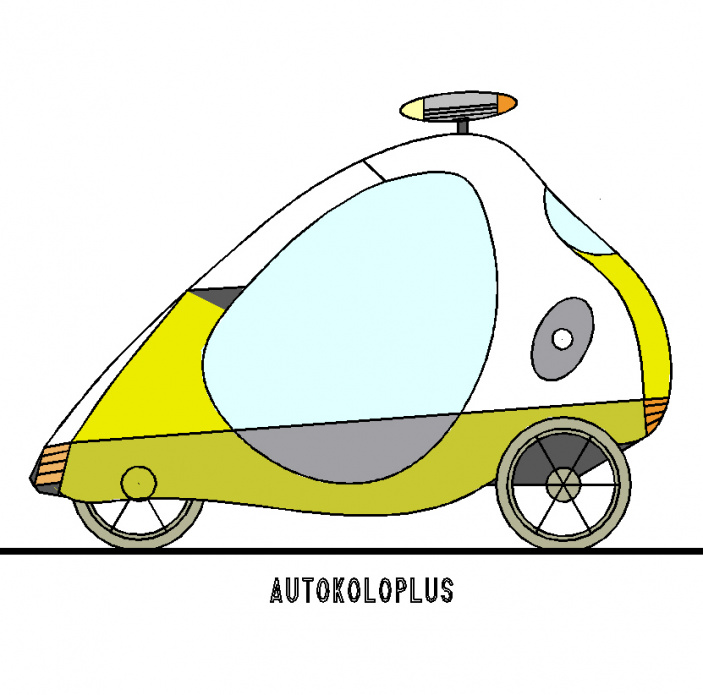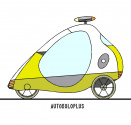AUTOKOLO PLUS
ID: #EN00009
Added: 27.09.2016
Rating:
Technical name: light passenger vehicle
Author: Böhm František
DESCRIPTION:
Many of today’s leading car manufacturers invest large sums in the development of electric vehicles…
Many of today’s leading car manufacturers invest large sums in the development of electric vehicles.
Despite their undeniable advantages (low noise, almost zero emissions of pollutants and greenhouse gases), they still have the disadvantages of existing cars (production costs, high demands on roads and parking areas and inefficient use).
In view of this, the way forward does not look too promising
Imagine the following situation: a woman weighing about 60 kg gets into her car, which weighs 1.5 tons, and drives to a shop one kilometre away. There she buys milk, bread, maybe a few other things, picks up her purchase with a maximum weight of 5 kilos and puts it into her car.
Therefore, in order to to transport her 60 kg and the 5 kg of goods, she has to warm up a mass of 1.5 tons and get it moving a few times, which consumes a relatively large amount of fuel (ie energy).
Or another typical situation: on the road we pass oncoming traffic.
In the vast majority of cars there is only one person.
Just on the basis of these two common situations, it is clear that the current schemes are unsustainable in the car industry.
As the centres of major cities are now practically impossible to reach by car, more and more people turn especially to bicycles - they want to follow their own path, independent of others.
According to statistical data it is clear that the sale of electric bikes in the Czech Republic is increasing annually by about one third. The situation in neighbouring countries is approximately the same.
However, a standard electric bicycle cannot be considered as a good long-term solution, as it places relatively high demands on physical fitness and skill (particularly disadvantageous for seniors and people with reduced mobility). In addition, the centre of gravity for the bike/rider system is located fairly high above the ground and there is no protection in the event of an accident. Because of all of these factors, it is necessary to redesign these bikes to have a larger frame.
Likewise, there is no protection against the weather.
With the increase in cycling, doctors (supported by research) are beginning to warn of the health risks associated with the frequent use of bicycles or electric bikes, in particular relating to the spine, nerves, and blood vessels supplying the sex organs.
A bike or electric bike does not resolve the optimum distribution of power in the case of a head-on collision with an obstacle. .
The frame is designed so that in a head-on collision all of the crash energy is directly transferred to the rider.
Let us imagine that we might combine the advantages of both bicycles and cars and remove their drawbacks.
Then we get a completely new type of vehicle, which we call autokolo (carbike).
It features a lightened frame structure, extremely low weight in relation to the size (The battery is easily recharged overnight in a socket or during the day in a carpark - it makes a difference whether you're recharging a vehicle weighing one ton, or only 80 kg).It has a bonnet like a car, provides a high level of safety and eliminates the risk in case of a frontal collision.
It has minimal parking requirements (four to five carbikes will fit in one car space). Additionally, it is suitable for women, seniors and persons with reduced mobility, and it may also have a wider application in the service industries and for those engaged in the minor trades.
It has a range radius of up to 30 km and is extremely friendly to the environment. .
The carbike can be characterized by a relatively high level of internal comfort, full and reliable protection against the weather and timeless design.
It should thus be attractive for different users, with the potential for widespread usage especially where there are historic buildings, and in protected and quiet areas.
This widespread use of carbikes will then lead to significant energy savings both during production and during the use and subsequent disposal of this means of transport.
And the icing on the cake: the designed carbike is very flexible as regards the possible seating positions of the rider, and its suitability for use in a variety of terrains - for urban, suburban, and rural traffic, and even on sand dunes and snowfields, using a single chassis with slight adaptations.
Thanks to its low weight it can be stored upright, easily transported on a truck or on railway wagons.
The distibution of the vehicle’s mass according to the new concept has resulted in a low centre of gravity for the whole object, which contributes to the stability of the vehicle and reduces the risk of accidents.
The construction according to the new concept allows the installation of a seat belt (two or three-point type), air bag, protective frame, headrest, and possibly other elements of modern safety equipment.
The body in the shape of a laterally flattened egg provides a low drag coefficient and ensures minimal damage in the event of an accident.
The upper surface of the body can be equipped with photovoltaic solar nano-collectors.
The new concept allows for the provision of some protection even to the outside participants of an eventual collision by using a dissipating mechanism that harmlessly absorbs the crash energy.
Its adequate protective function is conditional on not exceeding the maximum speed limit of the vehicle (as defined by the EU the maximum speed for electric bikes is 25 km / hr.), when the maximum overload at impact of pedestrian and driver will typically reach the same values as those of a car during heavy braking.
The vehicle according to the industrial design is lightweight, small, and achieves low acquisition and operating costs, has a large luggage compartment and is therefore particularly suitable for urban and suburban traffic, for which it has the optimum range radius.
This new concept of small vehicles according to the industrial design can be advantageously applied to bicycles, motorcycles, rickshaws and special-purpose vehicles (for example, in automated warehouse management) in single-track and multi-track versions and in single-seat or multi-seat versions.
Read more >
Key words:
electric bicycle, vehicle, car, pedaling
Patent or utility model number:
PV 2014-267
Level of completion:
3. Copyright
Scope of impact:
5. Global commercial use
Degree of efficiency:
5. Large, major impact on savings
Designed for:
4. For large manufacturers
Estimated price range of the product (in CZK):
5. More than ten thousands of crowns or thousands of euros
Offered share of development - manufacturing:
3. Up to 50%
Significance of the idea:
4.17



Discussion of the idea: